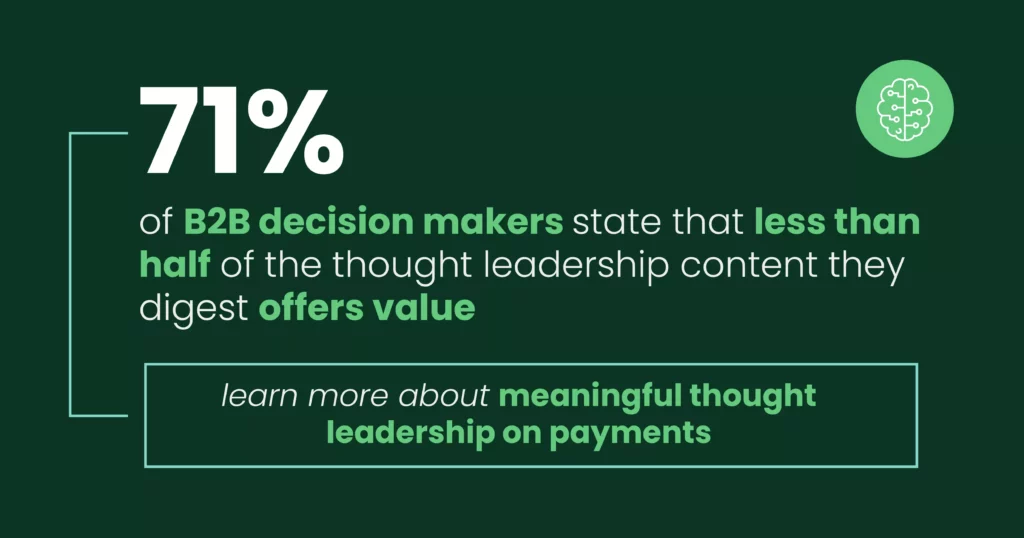
By Trevor Forbes, Director of Market Intelligence
Background
Renowned cognitive scientist Mark Turner said, “narrative imagining – story – is the fundamental instrument of thought. Rational capacities depend upon it.”
How does your company like to incorporate “narrative imagining”?
As a Director on the Market Intelligence team here at TSG, I enjoy good stories. Specifically, I enjoy creating unique content and stories on the global payments industry. After ten years in the industry, I have learned that there are so many facets to the realm of commerce, and more seem to pop up frequently. There are a lot of stories to tell.
Payment processing is a major B2B industry. According to a study of B2B decision-makers initiated by LinkedIn, 54% of B2B decision-makers purchased a new product/service from an organization they didn’t previously consider buying from, after consuming their thought leadership content. Additionally, 54% of decision-makers spend one hour reading thought leadership content each week.
On the downside, 71% of B2B decision-makers state that less than half of the thought leadership content they digest offers value. Some of the reasons for this is likely a lack of unique data – supporting insights are based on recycled content from the internet, the insight isn’t compelling, it isn’t tailored to a specific group, and it is too focused on selling vs. developing ideas.

Example
Here is a (very simple) hypothetical example. It is often viewed in our industry that price is the most important factor for merchants when it comes to selecting a point-of-sale (POS) system, and that robust feature sets are right next to the price in the order of importance. No doubt price and feature set are important when it comes to choosing a POS system, yet one study of small to medium-sized businesses conducted by our team shows that three of the top five reasons this type of merchant chooses a POS are related to ease of use. Conclusion: merchant-facing messaging around the point of sale should involve ease of use (if that’s offered).
Separately, needs, desires, and lingo vary by audience. Many payment processing companies have done a great job at concentrating on merchant industries they can serve well. Establishing partnerships with vertically focused independent software vendors (ISVs) is an example of this. I think we have all seen this boom in terms of merchant adoption, new ISV market entrants, and payment processing activity in the ISV space. After all, TSG’s AIM analytics platform shows that merchants boarded via the ISV channel stay with their payment processing provider approximately 41% longer than average.

Specialize
Merchants rely on software and payment processing players who know their unique needs. This type of business strategy needs a content strategy to match. Conduct surveys or interviews on specific audiences, learn the jargon and needs of a space and speak their language in thought leadership content. Add statistics that are not already out in the market that may show the audience something about their peers they may not have known. Interview subject matter experts within your company and have them be a voice for marketing. At the present time, I have seen this from at least some payment processing companies, so keep up the good work.
Conclusion
Unique data and tailored messaging can go a long way. Educate your audience and be a true thought leader.
If you could benefit from support in this area, our team would love to help. We support marketing teams in our industry in many ways via our BrandInfluence service. We offer:
- Customized surveys and interviews (on merchants, ISVs, consumers, etc.)
- Copywriting & graphic design (across whitepapers, infographics, & videos)
- Content distribution (leverage our channels to reach an audience)
- Branding flexibility (co-brand content pieces with us, or we can white-label them under your brand)
Contact us to discuss your thought leadership needs.
Here are some public examples: